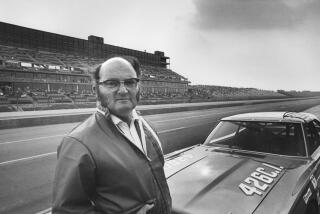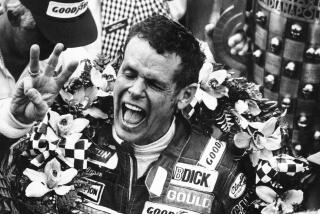The Shocking, Sudden End for Mickey Mach I
- Share via
I guess those of us who knew him always knew Mickey Thompson would wind up violently killed on a highway or road course or salt flat one day. We thought they would one day have to peel a car off him, drag a lake, or scale down to the bottom of a canyon where he would lie in the cab of an overturned truck, its wheels still spinning.
But none of us could have seen the shocking end that would come to his career--cut down by an assassin’s bullet with his wife, Trudy, as they emerged from their suburban home to go to work in the pre-dawn hours last week.
Death was no stranger to Mickey. They had met before on the treacherous swells of Lake Mead, the salt of Bonneville, the middle of Mexico, even the corners at Indy. Mickey could handle that. A guy with a gun and a grudge was something he didn’t get ready for, the one wreck Mickey couldn’t walk, or swim, away from.
Mickey was one of those guys you know for 25 years but you’re never quite certain what they look like because they’re always going by you at Mach I. Mickey was always in the biggest hurry of anyone I ever met.
Mickey learned to drive before he learned to walk. Mickey didn’t seem to have vital organs, heart and liver and lungs, like the rest of us. Mickey had spark plugs. Mickey ran on petroleum, not blood. He was never happy unless he had 600 or 700 horsepower under him or behind him or in front of him. Mickey never walked anywhere in his life.
He went through life like a guy escaping a bank holdup. He was the first person to go over 400 m.p.h. on the surface of the earth, reaching 406.6 m.p.h. at Bonneville in 1960. He was also the first guy to crash at that speed, although not during that particular visit.
It wasn’t that Mickey was accident-prone. He just wanted to go 5 m.p.h. faster than anybody in the world. It wasn’t his fault the machine couldn’t keep up.
He had the distinction of putting an end to the Mexican road race in 1954 when he plowed into a crowd of spectators and killed five of them. It wasn’t really Mickey’s fault. The townspeople had clustered around a wreck in the middle of the race course when Mickey came up at 150 m.p.h.
Actually, Mickey veered wildly and drove off a cliff or the carnage would have been much worse. His own rib cage looked like an elephants’ graveyard.
Mickey didn’t go fast only on land. He put a hydroplane in the water at Lake Mead for a water-speed record attempt in 1960.
Now, hydroplanes, I don’t know whether you know it or not, are the most delicate of racing machines. They are so finely tuned, they should run only in a bathtub, or on water so glassy you can see yourself in it. Just a Kleenex on the surface can send you orbiting to the moon and your boat after you.
Mickey crashed his hydroplane in the wake of a patrol boat and, the next thing he knew, was flying through the air and landing on water that, at those velocities, is like landing on concrete from a low-flying plane.
Mickey’s heart was broken. Unfortunately, so was his back. “Will I be able to race again?” he asked the doctors. “I don’t know,” they told him. “How fast can a wheelchair go?”
Mickey gave the medics six months to fix him up and then he went AWOL from the hospital in a van fitted with a mattress, an oxygen bottle--and a crucifix. When he asked them to recommend a doctor on the way, they gave him the name of the one they thought he would need--the coroner.
Mickey did promise to give up skydiving and water skiing but he was back in a car as soon as he could sit up without screaming and reach a foot pedal, without feeling as if someone had just kicked him in the back.
I guess I first came upon Mickey in 1962 when he was, characteristically, getting ready to take on the entire Indianapolis 500 racing Establishment.
Never one to sugarcoat it, Mickey was scornful of the front-engine prehistoric monsters Indy was racing in those days.
“Where do you put the horse?” he snickered as he got his first look at the Offenhauser-powered brutes Indy thought were the latest things in automotive design.
Mickey’s notion was that a race car should have the engine in the rear and be lightweight and maneuverable in the corners. He was right but that doesn’t always make you popular at Indy.
Mickey’s car wasn’t the first rear-engine racer at Indy. Jack Brabham had taken care of that the year before.
Still, Indy wasn’t convinced. Mickey was. Loudly. He had a 10-year belief in the supremacy of rear-engine machines. But when he showed up with an aluminum Buick engine mounted in the rear of a 1,000-pound chassis in ‘62, Indy laughed.
When Mickey’s Harvey Aluminum Special ran 93 hotly competitive laps with Dan Gurney at the wheel, though, no one was even smiling. And when one of Mickey’s cars finished the race, ninth, the following year, he proved to be a prophet. Within two years, there wasn’t a front engine on the grid anymore.
Mickey might have been prophetic and ahead of his time. But no one ever said Mickey was lucky. The next year, 1964, Mickey’s car was in the worst accident in Indy history.
Mickey put the rookie, Dave MacDonald in the cockpit. MacDonald triggered the accident that not only took his life but that of the veteran Indy favorite, Eddie Sachs, when MacDonald hit the wall on Lap 1 and exploded. Sachs, blinded by the black gasoline smoke, crashed into him and exploded.
Mickey’s life had been a dice with death from its start. It finally caught up with him in a manner no one could have foretold. No one figured Mickey, a man who lived his life on dead man’s curve, to die in a bed. But no one figured him to die in a hail of gunfire, either.
What would inspire a man to open fire on Marion Lee Thompson Jr. in that fashion is something for the police to puzzle out and the rest of us to be incredulous at. No one who knew Mickey can possibly comprehend.
But his strange passing marked the ultimate irony for Mickey Mach I: The men who killed him were riding bicycles.
More to Read
Go beyond the scoreboard
Get the latest on L.A.'s teams in the daily Sports Report newsletter.
You may occasionally receive promotional content from the Los Angeles Times.










